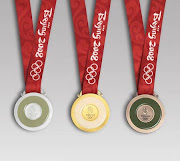 Above: Nadia Comaneci receiving the first-ever perfect 10 in Olympic competition, registered as a "1.00." 32 years later, the scoreboard will need four digits, and there will be no perfect 10 and no highest possible score.
Above: Nadia Comaneci receiving the first-ever perfect 10 in Olympic competition, registered as a "1.00." 32 years later, the scoreboard will need four digits, and there will be no perfect 10 and no highest possible score.If you are not a dedicated follower of gymnastics and just happen to watch the sport every four years at the Olympics, you are in for a MAJOR surprise. No Perfect 10! The only scenario in which one would see a 10 will be if a gymnast falls off the beam four or five times, has sloppy form and doesn't have lots of difficulty. So, obviously if you see a 10 at the Olympics it is NOT a good thing. The code of points is very confusing, but you don't need to know a "B" skill from a "C" skill in able to determine a good score from a bad one. The new open-ended code has no possible high score, like the new figure skating judging system. Scores vary from competition to competition, as they do from event to event. The 2008 Beijing Olympics are the first Olympics to use the new code, but they certainly won't be the last.
The Beginning of the New Code
The new code of points was adopted in 2006, and was triggered when South Korean Yang Tae-Young protested his parallel bars start value score after he finished 3rd behind eventual winner Paul Hamm in the Olympic AA final at Athens 2004. This controversy helped fire probably the most attention ever in the history of men's gymnastics, especially in the USA and South Korea. Bruno Grandi, who has definitely done more ill than good for gymnastics, publicly asked Hamm to give back his gold. The new code was successfully adopted and introduced to world competition in early 2006. Call me crazy, but I actually think another main reason Grandi adopted the new code was knowing that it would favor future Italian star Vanessa Ferrari's great difficulty and dramatic lack of execution much more than the old code.
A-Score
In plain English this is known as difficulty. Though many gymnasts and coaches try to say that the B-score (execution) is just as important, A is the grade everyone needs to be going after. Gymnasts who chuck skills with little regards to form and artistry generally wind up ahead of those who do the opposite. Great difficulty means more room for error, and also less room for backstabbing from judges who may not be politically favor a gymnast. It is generally the case that gymnasts with high difficulty get lenient execution scores as well.
B-score
In plain English this is known as execution. This is still encouraged, but it is no longer fatal to have sloppy form, boring artistry, or bobbles on skills as long as they are difficult. There are of course some exceptions (Natasha Kelley at '07 Nationals), but for the most part good execution isn't entirely necessary nowadays. Like in the old code, execution starts from a 10 while deductions are taken for flaws. Increased deductions (a fall off beam is .8 now, not .5) has done little to undermine to dominance of the difficulty score. The execution score is more the mark where the judges can be political. China's 'round the clock upgrades are likely a result of seeing the USA's significant political favor in the scoring at the 2007 Worlds.
Vault
On vault, gymnasts announce what vault they are performing prior to actually vaulting. Execution deductions are taken for poor form, steps, hops, falls, etc. with a "neutral deduction"(i.e. additional penalty) for stepping out of bounds (.1 for each foot out).
Double-twisting Yurchenko vaults are barely cutting it out now. If one comes to Beijing games without an Amanar or a Cheng and is hoping to medal in AA or vault finals, they're screwed. A DTY is worth a 5.8, while an Amanar or a Cheng is worth a 6.5, a whooping .7 difference in start value. A handspring Rudi vault is right up there with a 6.3 start value, and these are some of the vaults that are likely to be seen the most in Beijing.
Good scores on vault:
14.8 to 15.2 is very respectable
15.2 to 15.5 is very good
15.5 to 15.8 is excellent
15.8 to 16.1 is the highest range of score you should see on vault.
Uneven Bars
Uneven bars is the highest-scoring event for the women. He Kexin and Nastia Liukin have unveiled 7.7 A-scores for the Olympic year, and others are quickly ramping up their difficulty there as well. Getting a good mark on UB is all about strategy, and combinations. Release combos and especially pirouetting sequences are perfect opportunities for the girls to rack up all the points possible on this event. Execution perhaps takes a back seat on this event, but it is important as well. Missed handstands, low releases, and dead hangs are huge opportunities for deduction on this event.
Good scores on uneven bars:
15.4 to 15.6 very respectable
15.6 to 15.9 very good
15.9 to 16.2 excellent
16.2+ is top-standard.
We may just see 17's on bars, likely candidates to break that mark are Kexin, Liukin, and possibly Ksenia Semionova.
Balance Beam
A fall off the balance beam, the most infamous event in gymnastics, is no longer as costly as it used to be. Beam, next to bars, is the highest scoring event for the women. Routines with high start values that suffer a fall will often score higher than routines with low starting scores and clean execution. The Chinese take full-advantage of what the new code has to offer by getting bonus points in dance/acro combinations, as well as demonstrating their astounding flexibility in leaps and turns. The Americans lag behind a little bit in their starting scores because of their lack of connecting difficult skills together. Overly popular skills with the new code on beam include full-twisting back tucks, front somis, and leg-up full turns.
Good scores on beam:
15.3 to 15.5 is very respectable
15.5 to 15.8 is very good
15.8 to 16.1 is excellent
16.1+ is a top-score. Scores could be as high as around 16.50.
Floor Exercise
The floor exercise is the hardest event to score high on. Still, the new code has dramatically upped the standards in difficulty in both tumbling and dance. Even semi-decent floor workers go for broke with five tumbling passes. Fifteen years ago, three tumbling passes was the max. Judges are often strict with full revolution of twists, turns, and jumps alike. Artistry is no longer encouraged on this event, though at least their are some gymnasts still out there that choose to express good artistry and style. Look for tucked double-doubles and combination twist passes.
Good scores on floor exercise:
14.6 to 14.8 is very respectable
14.8 to 15.1 is very good
15.1 to 15.4 is excellent
15.4+ is worthy of Olympic FX gold.
Scores could be as high as 15.90.
My Opinions on the New Code
I don't actually hate this code entirely, as the old code was really falling apart from 2001 onward. During the 2001-2004 quadrennium, we were seeing a 9.7 as a great score when a decade earlier a 9.7 was considered very mediocre. The new code enables gymnasts to be fearless and risky to maximize their own potential. Gina Goegan's clean/conservative routine defeating Kui Yuanyuan's astoundingly difficult routine at the 1997 world championships will definitely not happen again. Gymnasts need to be extremely strong in order to compete all of the skills needed to be successful in the new code. This downplays eating disorders, and more and more I'm noticing different body types among gymnasts. Some gymnasts are long and lean, while others are very muscular and powerful. Diversity in gymnasts' body types is something that I LOVE and has definitely been popularized by the new code.
However, this code is very taxing on gymnasts' bodies, with several injuries happening at often heartbreaking times. The emphasis on difficulty is far too much, and appreciation for polish and style needs to come back. Different scores on each event and no hallmark "10" score lead to confusion even amongst the most passionate and knowledgeable of gymnastics fans. The new code has led to a regressing need for the AA, once the premiere event for all gymnasts. The newly alleviated consequences of falling during a difficult routine are not fair for gymnasts who pride themselves on good form and consistency.
The new code is hardly perfect, but I actually have some liking for it. Reducing the amount of elements counted for a difficulty score from 10 to 8 is a step in the right direction for the new code and the sport of gymnastics.
And Finally...
The Longines Award for Code Whoring goes to:
Vanessa Ferrari-Italy
Vanessa's immense determination and fearlessness makes her one of my favorite gymnasts. However, Vanessa is the definition of a code-whore by taking advantage of the scoring on every event. Chucking huge skills with sloppy form, questionable consistency, and low landings often leads me to believe that much of her tumbling skills are thanks to her small, compact stature, rather than Ferrari speed and power which everyone wants to see. I am not even going to comment on her full turn on beam. However, Ferrari looks to have improved her form a little, albeit at the expense of her difficulty. We will see if Ferrari's 2006/2007 code-whoring holds true at the Beijing Olympics. I have faith in Vanessa that she will improve her gymnastics come August.
Next Post: 2008 Chinese Nationals Analysis
That is all.






















2 comments:
"Loginess Award for Code Whoring"- haha
Another code-whore is Australia's Lauren Mitchell lol, especially on floor. Only gymnast I've seen who rebounds at the end of every. single. pass. All those rebounds don't make it look good and they look out of place. And not only does she get a bonus for rebounding out of passes, she also avoids not sticking her landings.
Post a Comment